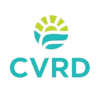By Peter Rusland, Cowichan News Leader Pictorial, July 07, 2011
Cowichan Bay gets cleaner by the litre with recent sinking of a longer outfall carrying sewage — treated to some of Cowichan’s highest standards — from the bay.
 Bay Director Lori Iannidinardo was satisfied the $2.2-million Lambourn Estates Sewer System project was federal gas-tax money well spent.
Bay Director Lori Iannidinardo was satisfied the $2.2-million Lambourn Estates Sewer System project was federal gas-tax money well spent.
“Sewage used to go into the bay, now it’s class-A effluent.
“It’s still going in the ocean, but 410 metres farther out,” she said of the new pipe installed June 22.
“You could practically drink the water coming from the system now.”
The $1.6–million Lambourn water and sewage treatment plant processes waste from about 130 Cherry Point area homes. It has capacity for 197 homes.
The plant sits at end of Sutherland Drive at Evelyn Place.
The Cowichan Valley Regional District also spent $328,000 of gas-tax cash making the new 410-metre pipe at the bay’s former Hayes log-sort site, then floated it out and hooked it to the existing Lambourn outfall built by developers in 1978.
That fix created a 530-metre discharge into Sansum Narrows.
The CVRD assumed ownership of the old Lambourn plant and outfall in September 2008, explained regional project engineer Jeralyn Jackson.
That’s when developers Royal Island, and Double-H Developments had created 50 new lots, but were required to upgrade the existing sewage and water treatment system under provincial regulations.
“It was a secondary-treated sewage, now it’s advanced secondary treatment through a membrane plant,” Jackson said of plant yielding “more than ditch-water” quality liquid, without using chlorine, before it’s pumped offshore.
“Effluent (at Lambourn) went from 12 million fecal coliforms (per 100 millilitres) down to less than 10.”
“Our number-one priority,” Iannidinardo said, “is to our shellfish (health and edibility), and Cowichan Tribes is satisfied too.”
Jackson was also happy about cleaner effluent entering the bay.
“It’s a major boost for Cow Bay, and it was 100 per cent funded through the federal gas-tax fund.
“It’s great bang for the buck.”
And for shellfish too.
“We’re adding the length to provide provincial setbacks required from shellfish beds in the Cherry Point area.”
When the bay’s septic pipes were rerouted to the Tzouhalem Road lagoons in the late ‘90s, Lambourn’s outfall became the bay’s biggest septic polluter, Iannidinardo explained.
“We need development-permit areas for the longevity of our bay,” she said, citing “lots more septage that has to be cleaned up.”
Waste worries include the bay’s lack of boat pump-out facilities, she and Jackson indicated.
“We hope all marinas in the village have pump outs. We really need to clean up our act on this,” Iannidinardo said.
Rodger Hunter, a Cowichan Watershed board member [co-ordinator of the Cowichan Watershed Board], called Lambourn’s cleaner operation “fabulous”, noting all local sewage-pollution sources must be pinpointed. “It’s all cumulative.”
Jackson said the bay’s government wharf has a sewage pump-out.
However, it was unknown if or what other bay marinas offer the vessel service that’s common stateside.
Jackson believed a proposal handed to the CVRD by the Cherry Point Marina could include hooking marina septage to Lambourn’s system.
The CVRD monitors Lambourn’s plant and outfall with regular sampling, she said.
 Email
Email



